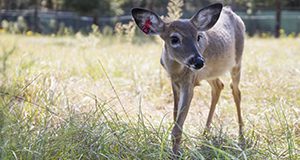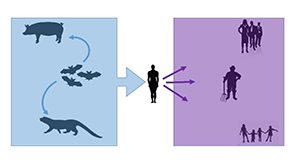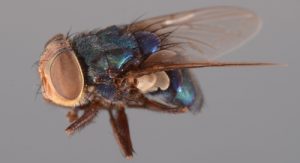Diseases carried by northern raccoons present significant health hazards to both people and pets. This 7-page fact sheet written by Caitlin Jarvis, Samantha M. Wisely, and Mathieu Basille and published by the UF/IFAS Department of Wildlife Ecology and Conservation is part of a series addressing health hazards associated with raccoons. It describes rabies, canine distemper, feline distemper, canine parvovirus, salmonellosis, and several other raccoon-borne viral and bacterial diseases of concern to people and their pets. Sick wild animals can act tame, but do not approach! Contact animal control or a wildlife rehabilitator if an animal seems to be behaving abnormally or if you suspect it is sick.
https://edis.ifas.ufl.edu/uw478
Tag: Samantha M. Wisely
Lumpy Jaw in White-Tailed Deer

Lumpy jaw is a deer health problem that all deer farmers eventually face. It gets its name from the swollen jaws or cheeks and necrotic lesions it causes in and around the jaw bones of animals including white-tailed deer. The disease is considered a significant problem for deer farms in North America, where it is one of the most important production-limiting diseases and causes high rates of mortality in fawns. This 4-page fact sheet written by Juan M. Campos Krauer, Samantha M. Wisely, and Hannah M. Barber and published by the UF/IFAS Department of Wildlife Ecology and Conservation explains how deer acquire lumpy jaw, how to spot it in deer, how to treat it, and how to prevent it in the first place.
https://edis.ifas.ufl.edu/uw472
Facts about Wildlife Diseases: Bats and Coronaviruses

Bats benefit both natural ecosystems and people. Viruses that live in bats can harm people, but transmission of these pathogens from bats to humans can occur only when humans come too close to bats. Recently, misguided attempts to preserve human health have led to persecution of bats. In fact, however, what will keep people healthy is to protect bats and their habitat. This 4-page fact sheet written by Holly K. Ober and Samantha M. Wisely and published by the UF/IFAS Department of Wildlife Ecology and Conservation explains how protecting bat roosts can reduce the likelihood of future zoonotic disease pandemics while also increasing the natural pest reduction services bats provide as they consume insects that cause damage to agronomic crops as well as the mosquitoes that transmit diseases like Zika, dengue, malaria, and chikungunya. Finally, protecting bat roosts keeps bats safely distanced from people, whereas destroying their homes risks the health of both people and bats because it forces bats into closer proximity to people.
https://edis.ifas.ufl.edu/uw473
Diarrhea in Farmed White-tailed Deer Fawns
Diarrheal diseases, commonly called scour, are common in newborn ruminant farm animals including deer fawns. The clinical presentation can range from mild diarrhea without systemic disease to profuse, acute diarrhea associated with rapid dehydration and death, sometimes within hours of onset. Determining the particular agents associated with an outbreak of diarrhea is important for both prevention and treatment. This 5-page fact sheet written by Juan M. Campos Krauer and Samantha M. Wisely and published by the UF/IFAS Department of Wildlife Ecology and Conservation focuses on disease in fawns caused by pathogenic types of Escherichia coli, describes the pathogens and how they infect fawns, and includes advice about treatment and prevention.
https://edis.ifas.ufl.edu/uw463
How Effective and Humane Is Trap-Neuter-Release (TNR) for Feral Cats?
As the number of feral cats continues to increase, land managers, public health officials, and private citizens are voicing concerns about how to address the nuisance and public health impacts, as well as animal welfare concerns, that feral cats create. Trap-neuter-release programs aimed at reducing feral cat populations without euthanasia are gaining popularity in the United States. But do they work? Authors Mark Hostetler, Samantha M. Wisely, Steve Johnson, Elizabeth F. Pienaar, and Martin Main discuss the pros and cons of trap-neuter-release programs in this 8-page fact sheet published by the UF/IFAS Department of Wildlife Ecology and Conservation.
https://edis.ifas.ufl.edu/uw468
Trueperella (Arcanobacterium pyogenes) in Farmed White-Tailed Deer
Trueperella is a harmless bacterium in intestinal tracts of ruminants like deer, cattle, and pigs, but if it migrates out of the intestine to other areas of an animal’s body and proliferates, it can make the animal sick. Trueperella causes many problems in deer, including lesions, abscesses, and pneumonia, and it is one of the types of bacteria that is known to contribute to the disease lumpy jaw. In young fawns, it is a common cause of death. This 3-page fact sheet written by Kathryn D. Pothier, Katherine A. Sayler, and Samantha M. Wisely and published by the Department of Wildlife Ecology and Conservation explains how to spot and treat trueperella, or, better yet, prevent it in the first place.
http://edis.ifas.ufl.edu/uw427
Primary Screwworm Cochliomyia hominivorax (Coquerel) (Insecta: Diptera: Calliphoridae)
In October of 2016, the United States Department of Agriculture confirmed that the primary screwworm, also called the New World screwworm, has returned to Florida. The fly was found infesting Key deer on Big Pine Key. Key deer are an endangered species found only on the Florida Keys, and unfortunately several have died from the 2016 screwworm infestations, but the screwworm is not only a problem for deer and other wildlife. The pest poses a serious threat to all warm-blooded animals, including livestock, pets, and people, and it cost the US livestock industry billions of dollars before it was finally eradicated decades ago. This four-page fact sheet provides more information about this dangerous pest and how to spot it, as well as what to do and whom to contact if you suspect an infestation in your livestock or pets or in a wild animal. Written by Phillip E. Kaufman, Samantha M. Wisely, and Jennifer L. Gillett-Kaufman and published by the Entomology and Nematology Department.
If you suspect an infestation of screwworms in an animal, do not move the animal (to prevent spreading the infestation). Call 1-800-HELP-FLA (1-800-435-7352) inside Florida. Non-Florida residents should call (850) 410-3800.
http://edis.ifas.ufl.edu/in1146
Facts about Wildlife Diseases: Hemorrhagic Fever in White-Tailed Deer
The viruses that cause hemorrhagic disease (HD) in deer do not cause illness in people, but they are a growing problem. HD is the most important viral disease of white-tailed deer in the United States. Large outbreaks have occurred in the northern Midwest and western United States. In Florida outbreaks are fewer and less severe in populations of wild white-tailed deer than are outbreaks among wild deer in other areas of the United States, but farm-raised deer in the state are proving vulnerable to epizootic hemorrhagic disease virus: one of the viruses that cause HD. This 6-page fact sheet written by Katherine A. Sayler, Charlotte Dow, and Samantha M. Wisely and published by the Department of Wildlife Ecology and Conservation describes best management techniques for outbreaks of HD in farm-raised deer. It includes strategies for best supportive care for sick animals, diagnostics, and integrated pest management to control biting midges that spread the viruses that cause HD, because the best way to manage HD is to prevent it.
http://edis.ifas.ufl.edu/uw411
Facts about Wildlife Diseases: Leprosy

Worldwide, 250,000 new cases of leprosy are reported each year, and in the United States, approximately 150 new cases of leprosy are diagnosed each year. Also known as Hansen’s disease, leprosy (Mycobacterium leprae) is a bacterial disease that infects the skin and nerves, causing disfiguring skin sores, nerve damage, and occasionally lung damage if left untreated. Leprosy is spread between humans via respiratory droplets when people sneeze or cough. In the southeast United States, handling armadillos is thought to be the source of many infections. This 4-page fact sheet written by Shannon P. Moore and Samantha M. Wisely and published by the Wildlife Ecology and Conservation Department describes the disease in humans and armadillos and explains how to avoid it and limit its spread.
http://edis.ifas.ufl.edu/uw408





